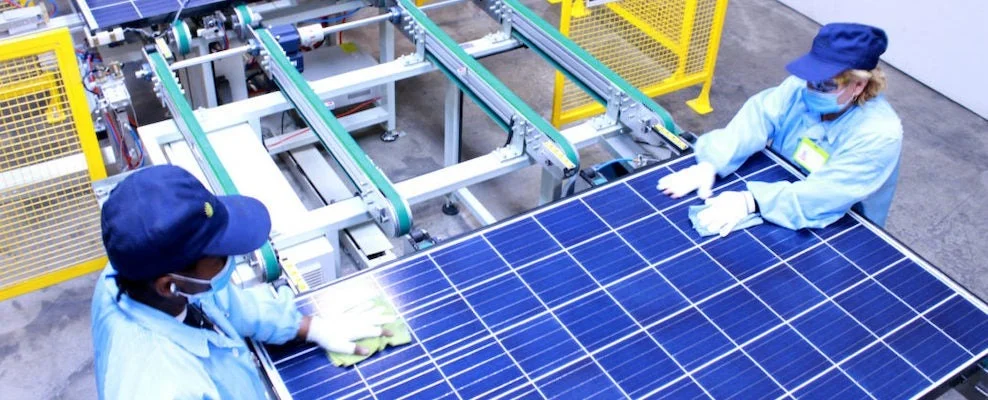It is a known fact that everything we do, from normal household chores to industrial or commercial work to launching satellites, depends on the use of energy. Most of this energy is generated using fossil fuels; while they are much needed for the functioning of our daily routine and for our society to run, they lead to the exploitation of fossil fuels and our environment, leaving a large carbon footprint.
The harnessing of natural energy like wind, water, and solar energy has brought drastic changes to our environment and in the field of energy production. It is abundantly available in nature with huge potential, ready to be harnessed and turned into renewable energy for the benefit of mankind and the environment. This blog will discuss solar energy, solar panels, and how solar manufacturers make them in the factory.
What Is Solar Power And Solar Panels?
Solar power is the energy harnessed from the sunlight. The energy radiated from the sun is renewable and green energy like thermal or electrical energy. Solar panels are devices that harness solar power to generate electricity using photovoltaic (PV) cells. The photovoltaic cells absorb the energy of the sunlight when the sunlight falls onto the surface of the solar PV panels, creating energy that creates electrical charges that move in response to the electrical field in the cell.
Making Of Solar Panels by Solar Manufacturers
Solar panels are usually made from semiconductors like silicon installed in a metal panel frame with a glass casing. When a very small packet of energy called photons from the sunlight hits the assembled materials, it releases electrons that produce electric charges. This is how sunlight energy is converted into electrical energy. Solar manufacturers produce panels in the industries following the steps mentioned below.
Silica Sand For Ingot Production
Solar panel manufacturers start by making cylindrical shaped silicon ingots, which are high-purity silicon produced from quartz sand in an arc furnace at very high temperatures. This process involves melting and solidifying silicon in a controlled environment. Special attention is given while melting so all the atoms are perfectly aligned in the desired shape and structure.
Ingot Into Wafer
Solar companies then slice the ingot into thin wafers using a precise diamond saw. These wafers are then cleaned and polished to remove any imperfections for better energy generation.
Solar Cell Production With Wafers
The solar manufacturers treat the wafer with chemicals and then coat it with a layer of phosphorus to create an electric field. Laser scribing is used to draw interconnected pathway patterns between adjacent cells of the cell strip.
Module Assembly
The solar companies connect the individual solar cells to form a complete module. This includes applying the copper ribbon in a process called tabbing or stringing. Then, they are encapsulated with a protective layer, and a support frame is added.
Test, Quality Control & Distribution
The modules then undergo vigorous testing to ensure they meet the quality, performance, and safety standards. Finally, when they pass the tests, they are packaged and shipped to customers.
Benefits Of Solar Energy
Renewable Energy
Solar energy is self-replenishing and is found abundantly in nature. It is a never-ending energy source that can be used to fuel the modern lifestyle and mankind’s development. It will create a better future for our coming generations.
Environmental Friendly
Fossil fuels emit a lot of pollution and create a carbon footprint. These fuels are not renewable, and the production and extraction process requires a lot of hand while natural energy, like solar energy, is easier to harness with no harmful or wasteful end product that pollutes the environment, making it a sustainable alternative to fossil fuel.
Balance Energy Exhaustion
Natural energy, like solar energy harnessed by solar PV panels, has lifted the heavy burden off other energy sources. This helps the ecosystem and gives time for other energy to replenish.
Save Money
Solar energy can save you money from electricity bills. The PV panels can harness solar energy and provide you with electricity to meet all your household or commercial needs.
Technology Development
Solar energy has helped in the development of society; we see rapid growth in industries and factories, leading to rapid development and also helping the growth of solar product manufacturers.
Multi-Purpose Energy
Solar energy can be used for various purposes in factories, households, or commercial areas, such as water supplies, electricity, or thermal power. It is even used by satellites as unreplenishable energy.
Conclusion
It is high time we switch to solar energy for our daily essential and commercial needs to do our bit to help the environment and the ecosystem since solar energy is renewable, sustainable, and money-saving. While many solar manufacturers manufacture the best solar PV panels, our top pick would be Inter Solar Systems, which has been trusted for its superior quality since 1997. We are a company where passion meets innovation, and we focus on lowering energy costs, ensuring reliability, improving performance, and increasing customer satisfaction through our solar products.
Our products include solar PV panels, solar water heating systems, and heat pumps. Researching and reviewing solar manufacturing plans is important to pick the best solar PV panels and other solar products to kickstart your sustainable and efficient journey. Switch to solar panels, use solar energy, and play your part in making our planet Earth a better place.

